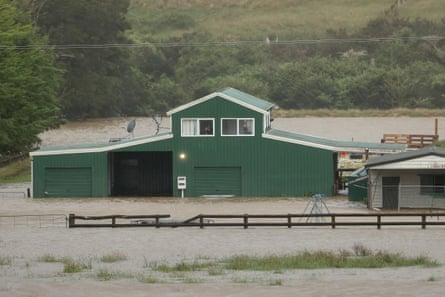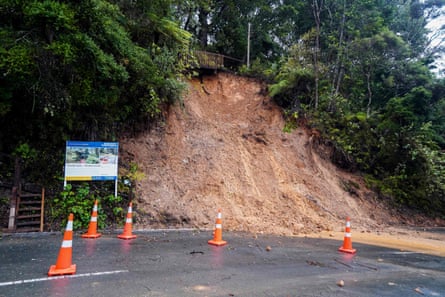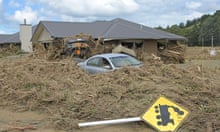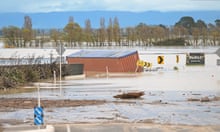New Zealand is in a national state of emergency, as Cyclone Gabrielle batters the country, with floods trapping people on roofs, thousands displaced and landslides destroying homes in what officials have described as an “unprecedented” natural disaster.
“Cyclone Gabrielle is the most significant weather event New Zealand has seen in this century. The severity and the damage that we are seeing has not been experienced in a generation,” the prime minister, Chris Hipkins, said on Tuesday. “We are still building a picture of the effects of the cyclone as it continues to unfold. But what we do know is the impact is significant and it is widespread.”
About 2,500 people have been displaced so far, officials said on Tuesday afternoon – but that number may shift, as there are still large areas that are unreachable and cut off from telecommunications.
The country announced a national state of emergency on Tuesday as the scale of damage inflicted by the storm emerged.
The emergency management minister, Kieran McAnulty, said Gabrielle was “an unprecedented weather event”.
It is only the third time in New Zealand’s history that a national state of emergency has been declared. The designation means the national government can send resources across the country to bolster civil defence efforts.

Flood waters rose to envelop homes and buildings in some areas: in Hawke’s Bay, people sheltered on roofs, with military helicopters unable to reach them in the weather. Landslides around the North Island swept away homes and cut off state highways.
Adrianne Mason, of Esk Valley in Hawke’s Bay, said her 22-year-old daughter had to climb out of her bedroom window in the middle of the night and swim to safety as flood waters rose, and neighbours were trapped on their roof by rising water. They have escaped to safety at a home on higher ground, but still cannot be reached by rescuers because the river has washed out roads.
The flooding was “catastrophic”, Mason said. Their newly built home had been immersed and other properties surrounding the river “have lost their houses completely,” she said.
On the East Cape, a farmer in Tolaga Bay described enormous destruction as floods carried “300kg logs, huge logs, one after another, rolling off the forestry up above us”. The water came “pouring out over people’s homes and farms”, Bridget Parker told Radio New Zealand. “We prepared for the worst. Nothing prepares you for this carnage. Is anybody coming to help?”
With a number of regions completely cut off on Tuesday, assessing the extent of the damage was proving extremely difficult, and there were no formal numbers so far on people evacuated, injured, or homes destroyed.
“It will take us a while to get a handle on exactly what’s happened,” Hipkins said earlier on Tuesday. “A lot of families displaced, a lot of homes without power, extensive damage done across the country.”
He said recovery from the storm’s damage was likely to be lengthy. “This won’t be an overnight recovery. It’s going to take a while – some people will be displaced from their homes for an extended period of time,” Hipkins said.

The cyclone comes on the heels of devastating flooding in Auckland and Northland, which caused extensive damage a fortnight earlier.
The climate change minister, James Shaw, said of the cyclone’s devastating effects: “This is climate change.”
In a furious speech to parliament, he decried “the lost decades that we spent bickering and arguing about whether climate change was real or not, whether it was caused by humans or not, whether it was bad or not, whether we should do something about it or not”.
He added: “We cannot put our heads in the sand when the beach is flooding. We must act now.”
The prime minister indicated the cyclone – and other extreme weather events – would have to change how and where New Zealand builds its communities.
“We need to look at the sustainability of some of the places where we have built previously,” he said. “We’ve got a long history of poor past decisions in New Zealand that we’re confronting right now.”
The worst-affected areas appeared to be around the east coast and far north of the North Island. Some communities, such as the coastal region of Gisborne/Tairāwhiti, parts of Hawke’s Bay and Northland have been cut off entirely, lacking power, mobile networks or road access. Fire and Emergency New Zealand said it had lost all communication with crews on the ground in the early hours of Tuesday morning, while civil defence workers were communicating by satellite phone.
Flood waters rose to envelop homes and buildings in some areas: in Hastings, some people sheltered on roofs. Landslides around Auckland’s west coast swept away homes and cut off roads.
McAnulty said that while “we are through the worst of the storm itself, we are all facing extensive flooding slips, damaged roads and infrastructure”.

“Our message to everyone affected is safety first: look after each other, your family and your neighbours,” he said. If people were facing dangerous conditions, he urged them to proactively evacuate: “If you are worried about your safety, particularly because of the threat of flooding or slips, then don’t wait for emergency services to contact you: leave and seek safety.”
By Tuesday afternoon, power was cut off to 225,000 people across the North Island, the energy minister, Megan Woods, said. The national grid operator warned that power might not be restored to some for “for days to weeks, rather than hours”.
The National Emergency Management Agency’s national manager of operations, Roger Ball, said: “The situation is really evolving minute by minute. We’ve got self-evacuations at the moment and formal evacuations under way.”
The conditions were making evacuations and rescues difficult. One firefighter was in a critical condition and another still missing after a landslide destroyed the house they were inspecting in Muriwai, west Auckland.
McAnulty said emergency workers were struggling with access in a number of regions across the North Island. “The unstable ground, the flood waters, closed roads [are] making their job incredibly difficult. The options that would be available to them normally, such as helicopters, may not be possible with the extent of the weather,” he said.








